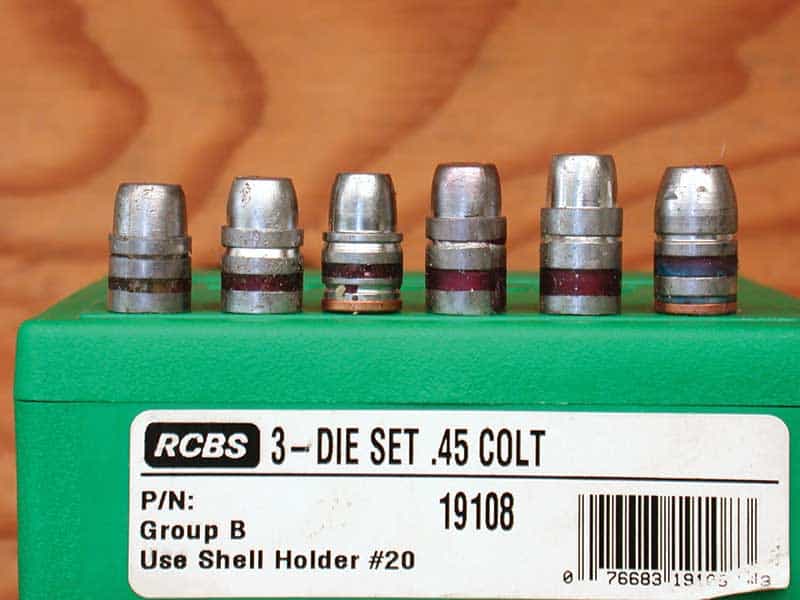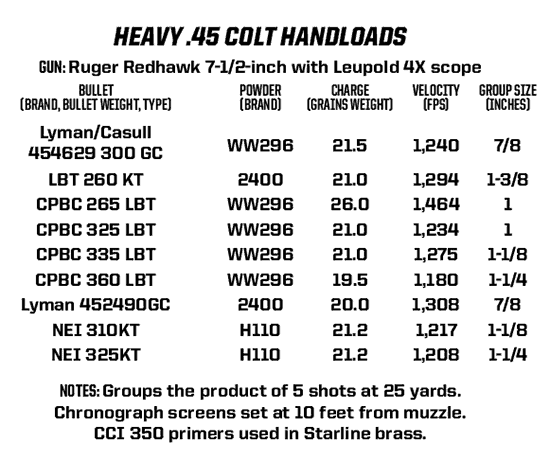The Venerable,
Versatile .45 Colt
One Of Our Oldest Cartridges Is Still One Of Our Best
When the Army announced trials to select a new revolver in 1872, the winner was the Colt Single-Action Army, and it’s probably the most famous revolver in history. The original sixguns carried 7-1/2-inch barrels and used a very powerful round with a 255-grain bullet over 40 grains of black powder. This load, deemed too powerful, was cut back to 30 grains while the civilian load was standardized at 35 grains of black powder.
Before looking at loads for the .45 Colt let’s dispel the age-old myth .45 Colt brass is weak. There was some basis for this prior to WWII, however, all of this ended in the early1950’s with the advent of solid-head .45 Colt cartridge cases.
If .45 Colt brass was weak we would not have the .454 Casull today. Dick Casull’s experiments using .45 Colt brass would eventually lead to the .454 Casull. But there exists such a wide range of revolvers accepting the .45 Colt you must exercise great care assembling loads. SAAMI sets maximum standards for cartridges, however, this must be set at a level safely usable in the weakest common gun. For the .45 Colt this is the Single-Action Army. Heavy loads safe for use in the Ruger Redhawk would destroy a fine Colt SAA.
In ranking the various .45 Colt sixguns now in production from the least strong to ones capable of handling the heaviest loads, I would list the following order: Colt Single-Action Army, Colt New Frontier, Ruger New Model Flat-Top and Smith & Wesson Model 625. All are very close together strength-wise and should be confined to standard loads. Then comes the Freedom Arms Model 97, Ruger Blackhawk, Ruger Redhawk and Super Redhawk. Custom 5 shooters built on the Ruger Blackhawk and Redhawk, and the Freedom Arms Model 83 top the list.
Maximum Defined
A question I often receive is “What is a maximum load for my revolver?” Anyone asking such a question does not really understand the use of the term maximum. No one can tell you what is maximum for a particular revolver as every sixgun is a law unto itself. Variables such as tolerances, or lack thereof, barrel/cylinder gap, barrel groove diameter, diameter of chamber mouths, powder, primer, bullet diameter and all contribute to pressure. What is maximum in one gun may be mild in another, and vice versa—exactly why all loading manuals have starting loads. These are mandatory beginning loads for the wise reloader. The same warning in all loading manuals also applies here: Any data I provide needs to be approached carefully and cautiously and all loads above what I label as standard should begin at the lowest level.
After the maximum load question comes the question of bullet diameter. If you’re using jacketed bullets, there is very little choice as virtually all of these are either 0.451 or 0.452 inch in diameter. However, when it comes to cast bullets, especially if we cast our own, we do have a choice. When I size bullets I mostly use either 0.452 or 0.454 inch depending which size fits the cylinder. With today’s guns, this usually means the smaller size for Ruger and Freedom Arms sixguns, and the larger size when loading for the Colt Single Action and replicas thereof.
From early on I used maximum loads in my Colt Single Actions. These days, both my Colt sixguns and I have become older and, in my case, mellower to the point of not using or needing this much power consistently. My standard load today is 8.0 grains of Unique assembled with Lyman’s 260-grain 454424 Keith bullet.
Power & Bullets
In the .45 Colt, H4227 is almost magical and able to provide excellent accuracy when others won’t. In fact, an axiom with me is, “When all else fails, try H4227 before giving up.” One 4-3/4-inch Colt New Frontier I have is a mediocre performer except with Lyman’s 454424 and 20.0 grains of H4227, a combination which turns out to be capable of 1-hole groups. I have also been having good luck lately with 10.0 grains of HS6 and 250- and 260-grain bullets. My brass of choice is Starline with either CCI 300 Standard primers for standard loads or 350 Magnum primers for magnum-type loads.
Not always having time to cast my own, I am thankful for Oregon Trails’ 255-grain semi-wadcutter. I have used thousands upon thousands of these SWC bullets for my standard loads finding they will often outshoot my carefully cast, sized and lubed home-cast bullets. It is not at all unusual to find standard loads with this bullet capable of shooting 1-hole groups at 25 yards.
Keith originally designed his bullet, Lyman’s 454424, with three equal diameter full-caliber bands, a large square-cornered grease groove, and a deep crimping groove. Lyman no longer offers this bullet having replaced it. The current 452424 is not a true Keith bullet. The original Lyman Keith mold is not all that difficult to locate at gun shows or on the Internet. Two currently produced RCBS .45 Colt Keith bullet molds are the 45-255KT—a virtual dead ringer for Lyman’s old 454424—and the 45-270 SWC, a slightly heavier version. These are both excellent bullets.
Ray Thompson designed several gas-checked bullets for Lyman in the 1950’s. His 260-grain gas check is often the answer for barrels prone to leading or for higher velocity loads. With 20.0 grains of 2400 this bullet clocks out at just over 1,300 fps in a Ruger Redhawk and is a tack driver. Keith always denounced gas checks on bullets, however, some .45 Colts simply shoot gas-checked bullets better than standard ones. Gas checks are often mandatory for use in lever-action rifles chambered for sixgun cartridges.
There were no heavyweight bullets available when I began reloading for the .45 Colt in the mid-1950’s. This was no problem and I was perfectly content to shoot standard weights in Colt Single Actions. The coming of the Ruger Blackhawk in the early 1970’s changed all of this. Now we had a single-action .45 with a longer, heavier cylinder and it was not long before published data using heavy .45 Colt loads began to appear. At this time, there were no 300-grain bullets available for use in the .45 Colt, and those of us who wanted to shoot heavier bullets found it necessary to size .45-70 bullets to fit the chambers of the Ruger. But for the last 30 years we have had several excellent heavyweight .45 Colt bullets available.
NEI has two great heavy Keith-style bullets in their 310.451 and 325.454 weighing in at approximately 300 and 325 grains. My favorite load for either of these is right at 21.5 grains of H110 or WW296 for 1,200 fps. These are both plain-based bullets. An excellent gas-checked version—in fact my most used 300-grain bullet in the .45 Colt—is one designed by Dick Casull for Lyman (454629) and for use in the .454 Casull. This flatnosed bullet casts out around 305 grains. Using this 305-grain bullet over 21.5 grain of H110, I have shot both the 7-1/2-inch Ruger Blackhawk and Freedom Arms 4-3/4-inch Perfect Packin’ Pistol to a full 700 yards with exceptional accuracy. The same load and bullet also shoots superbly in Ruger’s Redhawk.
Cast Performance Bullet Co.’s wide range of gas-checked, hardcast, LBT bullets are just the ticket for heavy hunting loads. Weights run from 265 grains up to 360 grains with all showing excellent accuracy when heavily loaded in a Ruger Redhawk. For hunting deer-sized animals my choice is a jacketed hollowpoint weighing 240 to 260 grains over 25.0 grains of H110 for right at 1,250 fps from a 7-1/2-inch Ruger Blackhawk.
The .45 Colt could easily be described as the most versatile of sixgun cartridges. It has been wrongly pronounced legally dead by so many “experts” and resurrected so many times, it is probably finally here to stay. It began as a black powder cartridge in 1873, and now 144 years later, this same cartridge can equal—even surpass—the .44 Magnum in many factory-produced sixguns and nip at the heels of the .454 when used in custom-built revolvers with 5-shot cylinders. No other sixgun cartridge has such a wide range of practical usability.
These loads were safe only in the firearms tested. Be responsible. Reduce loads and work up to maximum for your firearm. Due to the inherent variables in the reloading of ammunition, be sure to verify any published loads with current manufacturer’s data. Be aware, and be safe!












